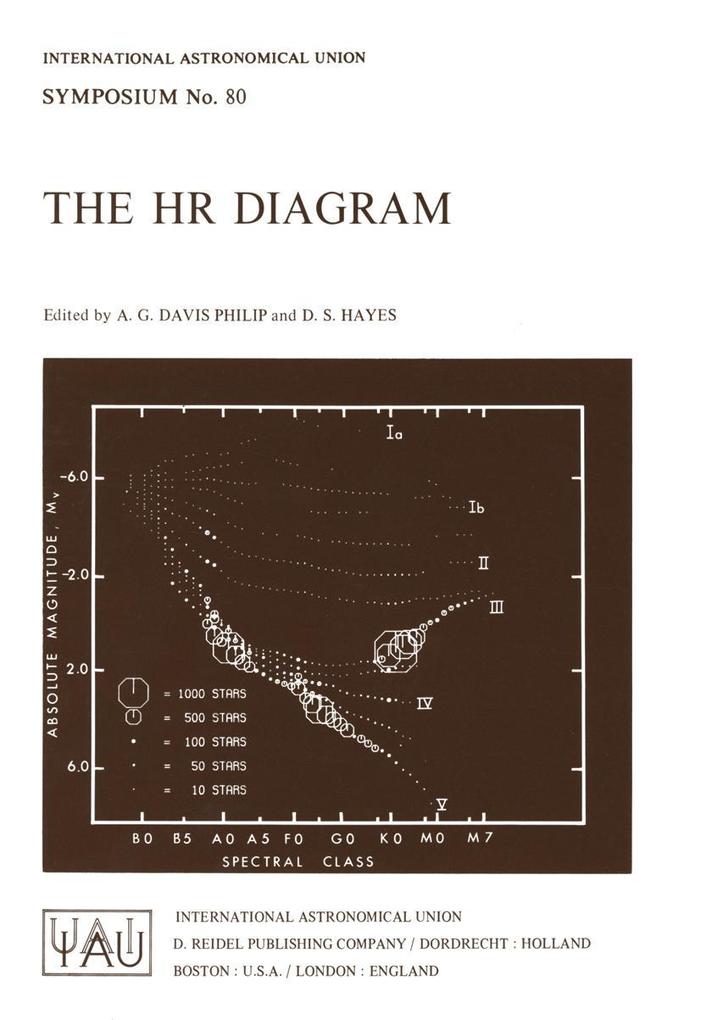IAU Symposium No. 80, The HR Diagram - The 100th Anniversary of Henry Norris Russell was held on November 2-5, 1977 at the National Academy of Sciences in Washington D. C. , in order to commemmorate the birth of Henry Norris Russell on October 25, 1877 and to review current problems in the use of the Hertzsprung-Russell diagram. The IAU has sponsored two previous conferences concerned mainly with the HR diagram; The Position of Variable Stars in the Hertzsprung-Russell Diagram, a colloquium held at Bamberg in 1965 and The Hertzsprung Russell Diagram (IAU Symposium No. 10, J. L. Greenstein, ed. ) held in Moscow in 1959. In 1974 a conference, Multicolor Photometry and the Theoretical HR Diagram (Dudley Obs. Report No. 9, A. G. D. Philip and D. S. Hayes, eds. ) was held in Albany, N. Y. ; and in 1964 a conference, Basic Data Pertaining to the Hertzsprung-Russell Diagram, was held at the Flagstaff Station of the U. S. Naval Observatory in honor of Ejnar Hertzsprung and to dedicate the 61-inch astrometric reflector. (Vistas in Astronomy Vol. ~, A. Beer and K. Aa. Strand, eds. , Pergamon Press, Oxford). Volume 12 of Vistas in Astronomy, The Henry Norris Russell Memorial Volume (1970), contains a review paper on Changing Interpretations of the Hertzsprung-Russell Diagram 1910-1940, A Historical Note by B. W. Sitterly.
Inhaltsverzeichnis
I. Fundamentals of the HR Diagram. - Some Uses of Spectral Classification in HR Diagrams. - Some Progress and Problems in the Upper Left of the HR Diagram. - A More Accurate HR Diagram for the Cooler Stars. - Spectroscopic Observations of Late-Type Halo M Dwarfs. - A Computer Method for Spectral Classification. - Red and Blue Stars in the Direction of the Large Magellanic Cloud. - Quantitative Two-Dimensional Classifications of Low Dispersion Objective Prism Spectra. - Carbon and Late-Type M Stars as Population Indicators. - Main Sequences Defined by Hyades and Field Stars. - Absolute Magnitudes by Statistical Parallaxes. - RR Lyrae Variable Stars and the Distance Scale. - Extensions of the Wilson-Bappu Effect Among Very Luminous Stars. - Statistical HR Diagrams for One Hundred and Fifteen Thousand Proper-Motion Stars. - The Absolute Calibration of the HR Diagram: Fundamental Effective Temperatures and Bolometric Corrections. - II. HR Diagrams, The Solar Neighborhood. - Hertzsprung-Russell Diagrams and Color-Luminosity Diagrams for the Stars Nearer than Twenty-Two Parsecs. - The Position of the Sun in the HR Diagram. - HR Diagrams Derived from the Michigan Spectral Catalogue. - III. HR Diagrams, Subluminous Stars. - The HR Diagram. - The Distribution of Masses and Radii of White Dwarf Stars. - The HR Diagram of White Dwarfs. - Ultraviolet Colors of Subdwarf O Stars. - Subluminous Stars in the HR Diagram. - Empirical Evidence for Crystallization Sequences of DA Type White Dwarfs. - IV. HR Diagrams, Clusters. - Spectrophotometry in Stellar Associations. - A Photometric Study of Ara OB1. - Four-Color and H? Diagrams for Open Clusters A Survey. - The Main Sequence of NGC 6231 and the Calibration of Absolute Magnitudes. - The Hyades Cluster Too Distant? . - The Occurrence of Peculiar Stars in OpenClusters. - The Clump Giants: A Spectroscopic Survey of G and K Giants in Open Clusters. - K-Line Photometry: Coma and NGC 6475. - Measurements of Abundances and Ages of Old Disk Clusters. - Evidence for Non-Homogeneity in the Metal Abundances of Stars in Globular Clusters. - A Comparison Between the Relative Heavy Metal Abundance of the Extreme Halo Field Stars and Giant Stars of Globular Clusters. - Observations of CO and OI in Stars in Globular Clusters. - The Chemical Abundances of the Halo Clusters of the Galaxy. - A Combined Photometric/Spectroscopic Study of RR Lyrae Stars in the Globular Cluster Omega Centauri. - The Role of Mixing and Primordial Abundance Variations in 47 Tucanae and ? Centauri. - The Anomalous Giant Branch of ? Centauri. - V. HR Diagrams, Horizontal Branch. - Horizontal-Branch Stars in the Log Teff, Log G Diagram. - The Expected Morphology of Zero Age Horizontal Branches. - Evolution of Globular Cluster Stars with Mass Loss and Core Rotation. - Physical Properties of Cepheids and RR Lyrae Stars. - Pulsation Modal Behavior of Classical Cepheids in the HR Diagram. - The Radii of RR Lyrae Stars. - VI. Galaxies and Miscellaneous Subjects. - HR Diagrams of Galaxies: Ages and Stages of Evolution. - Luminosities of LMC OB Stars. - The HR Diagram for Luminous Stars in Nearby Galaxies. - A Preliminary Color-Magnitude Diagram for the Ursa Minor Dwarf Galaxy. - The Hertzsprung-Russell Diagram of Metal-Poor Disk Stars. - The Use of Praesepe for the Definition of the Lower Part of the Zero-Age Main Sequence. - A New Kind of HR Diagram? . - Detection of Am and Ap Stars by Photometric Means. - The HR Diagram of Abnormal A-Type Stars. - From Multicolor Photometric Indices to the HR Diagram. - VII. Theoretical Papers and Summary. - The Vogt-Russell Theorem, and New Results on an OldProblem. - Comparison Between Observational and Theoretical (Log Teff, Mbol) Diagrams. - Is it Possible to Derive the Position of a Star in the HR Diagram from Multicolor Photometry? . - On Magnetic Mixing and Rotation in Stellar Evolution. - Survey of Some Recent Stellar-Evolution Calculations. - The Evolution of the Integrated Colors of Globular Clusters and Elliptical Galaxies. - Evolution of Massive Stars Through Late Evolutionary Phases. - The Structure and Evolution of Massive Stars. - Evolution of Massive Stars: When Does an Of Star Become a WR Star? . - Nucleosynthesis in Massive Population II Stars. - The Colors of G and K Giant Stars. - Microturbulence as a Third Dimension in the G-K Giant Region of the HR Diagram. - Sphericity Effects of Extended Atmospheres of Late-Type Giants in the HR Diagram. - Summary. - Continuation of Discussion. - Poster Session. - A Revised Classification System in the Red for S Stars. - Southern High-Velocity Stars. - On G. P. Kuiper s Work on the Stars of Large Proper Motion. - A B-Star High Luminosity Indicator. - The Main Sequence at G2 V. - Optical and Infrared Properties of the Newly Formed Stars in CMa R1. - Luminosity Calibration of Late-Type Stars by Statistical Parallax using AGK3 Proper Motions. - Fundamental Parameters and the Helium Content of Eclipsing Spectroscopic Binaries. - Extending the White Dwarf Sequence: Plans and Prospects. - Peculiarities in Some Cluster Color-Magnitude Diagrams. - The Strömgren Four-Color System and the log Teff, the Log G Diagram. - Angular Diameters of Cool Stars Measured by the Method of Lunar Occultations. - Two-Dimensional Spectral Clasification of M Stars by Narrow-Band Photometry.














